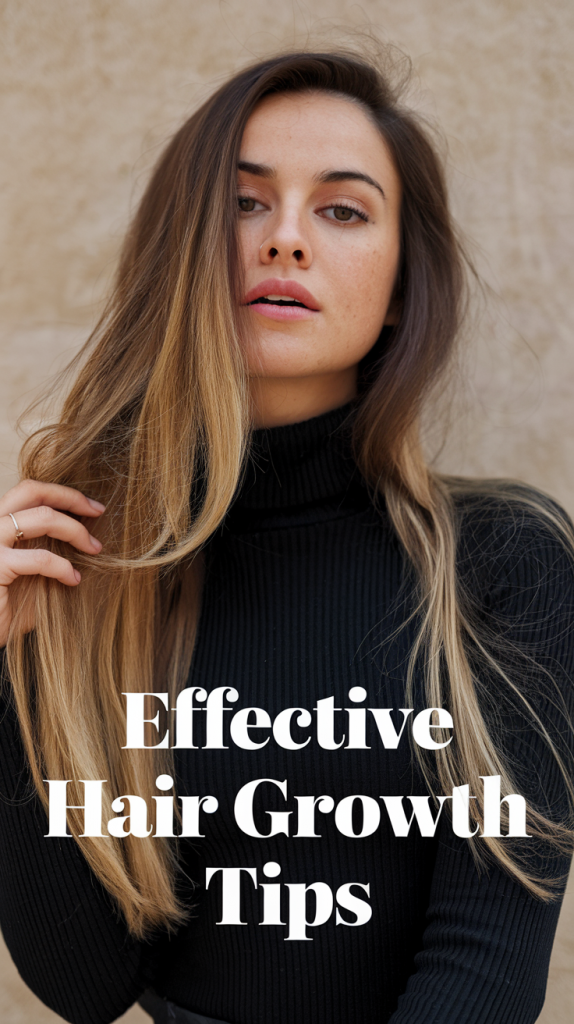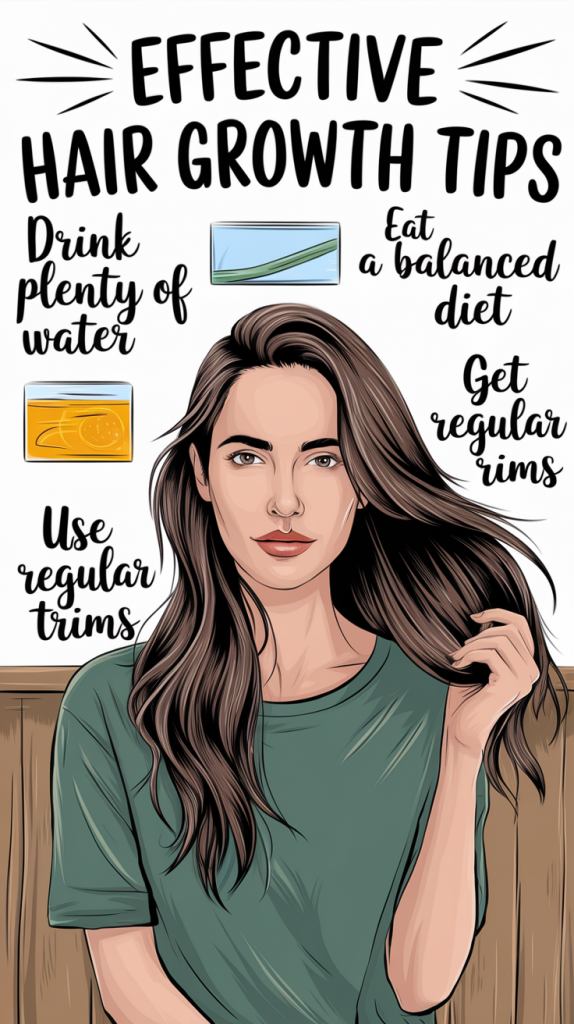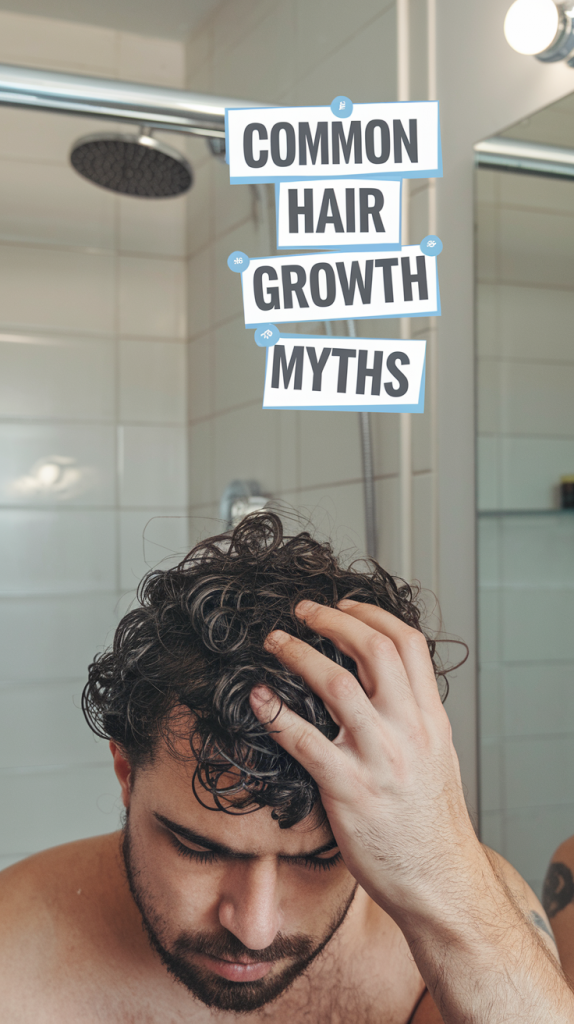Hair Growth Tips
Achieving healthy, vibrant hair is a goal shared by many, and growing your hair longer and stronger often feels like a mystery. Through personal experience and extensive research, I’ve uncovered strategies that genuinely work. In this comprehensive guide, I’ll dive into the best tips for promoting hair growth while addressing the most common questions along the way.

Understanding Hair Growth
Hair growth happens in cycles, and knowing these stages can help you understand how to optimize growth:
- Anagen Phase: This is the active growth phase, lasting 2-8 years, where hair grows about half an inch per month.
- Catagen Phase: A brief transitional phase of about 2 weeks where hair follicles shrink.
- Telogen Phase: The resting phase, lasting 2-3 months, where old hair stays in place while new hair begins to grow.
- Exogen Phase: Shedding phase, where old hair falls out, making room for new growth.
Since each hair strand is in a different stage of growth, it’s normal to lose 50-100 hairs per day.
| Hair Growth Phases | Duration | Description |
|---|---|---|
| Anagen | 2-8 years | Active growth phase |
| Catagen | 2 weeks | Transitional phase where follicles shrink |
| Telogen | 2-3 months | Resting phase |
| Exogen | Variable | Shedding of old hairs |
Effective Hair Growth Tips
1. Maintain a Healthy Diet
What you eat has a profound effect on your hair’s health and growth rate. A nutrient-rich diet fuels the hair follicles from within.
- Proteins: Eggs, lean meats, fish, and legumes supply amino acids that are vital for keratin production.
- Vitamins and Minerals:
- Biotin: Found in nuts, eggs, and sweet potatoes, it’s a key nutrient for hair strength.
- Vitamin D: Boosts hair follicle cycling; get it through fortified foods and sunlight.
- Iron: Critical for oxygen delivery to hair roots; find it in spinach, red meat, and lentils.
- Zinc: Supports scalp health; sources include pumpkin seeds and shellfish.
Quick Diet Tips:
- Incorporate leafy greens, nuts, and seeds into your meals.
- Drink plenty of water to keep your scalp hydrated.
| Nutrient | Key Benefits | Sources |
| Protein | Builds keratin | Eggs, meat, fish, legumes |
| Biotin | Strengthens hair | Nuts, eggs, sweet potatoes |
| Vitamin D | Boosts follicle cycling | Sunlight, fortified foods |
| Iron | Improves oxygen delivery | Spinach, red meat, lentils |
| Zinc | Supports scalp health | Pumpkin seeds, shellfish |
2. Scalp Care is Essential
A healthy scalp is the foundation of strong hair growth. Ignoring scalp health can hinder your progress.
- Regular Scalp Massages: Stimulates blood circulation to the follicles.
- Use fingertips or a scalp massager.
- Incorporate oils like rosemary or peppermint, which studies suggest promote hair growth.
- Exfoliation: Use scalp scrubs or gentle brushes to remove buildup and unblock hair follicles.

DIY Scalp Oil Recipe:
- Mix 5 drops of rosemary essential oil with 2 tablespoons of coconut oil.
- Warm slightly and massage into your scalp for 5 minutes.
- Leave it on overnight for best results.
3. Be Gentle with Styling
Excessive heat, chemicals, and tight hairstyles can damage hair and impede growth.
- Avoid Heat Styling: Minimize the use of flat irons, curling wands, and blow dryers. Use heat protectants when necessary.
- Skip Harsh Chemicals: Frequent dyeing, perming, or relaxing can weaken hair shafts.
- Opt for Protective Styles: Loose braids, buns, or twists prevent breakage.
4. Use the Right Hair Care Products
Your hair care routine should support your growth goals. Here are some essentials:
- Sulfate-Free Shampoos: Gentle on the scalp and preserve natural oils.
- Deep Conditioners and Masks: Strengthen strands with ingredients like argan oil, keratin, or aloe vera.
- Growth Serums: Look for products with caffeine or minoxidil to stimulate the scalp.
5. Explore Advanced Treatments
For those seeking quicker or more noticeable results, consider modern hair growth therapies:
- Laser Therapy: Low-level laser devices can stimulate hair follicles.
- PRP (Platelet-Rich Plasma): A medical treatment where your platelets are injected into the scalp to encourage growth.
- Microneedling: Boosts collagen production and improves absorption of topical treatments.
6. Manage Stress and Lifestyle Factors
Chronic stress disrupts the hair growth cycle, leading to shedding and thinning.
- Relaxation Techniques: Practice yoga, meditation, or mindfulness to lower cortisol levels.
- Adequate Sleep: Aim for 7-9 hours of quality sleep per night.
- Environmental Protection: Use hats or scarves in polluted areas to protect hair from damage.
| Lifestyle Factor | Impact on Hair Growth | Solution |
| Stress | Disrupts growth cycle | Yoga, meditation, relaxation |
| Poor sleep quality | Slows down hair regeneration | 7-9 hours of sleep daily |
| Environmental pollution | Weakens hair structure | Protective hairstyles, scarves |
Common Hair Growth Myths
- Frequent Trimming Grows Hair Faster: Trimming prevents split ends but doesn’t affect the growth rate.
- Over-Brushing Stimulates Growth: Excessive brushing can lead to breakage.
- Only Expensive Products Work: Affordable natural remedies, like coconut oil, are just as effective.
A Sample Weekly Hair Care Routine
Day 1: Deep-condition with a mask rich in keratin.
Day 2: Scalp massage with essential oils.
Day 3: Wash with a sulfate-free shampoo and follow with a light conditioner.
Day 4: Rest day; avoid styling tools.
Day 5: Apply a growth serum.
Day 6: Protective hairstyle and hydration.
Day 7: Scalp exfoliation and leave-in conditioner.
FAQs
Q1: How long does it take to see results with these tips?
Consistency is key; noticeable changes can take 3-6 months.
Q2: Can supplements improve hair growth?
Supplements with biotin, zinc, and collagen can support growth but consult a doctor first.
Q3: Is shedding normal during hair growth?
Yes, losing 50-100 hairs daily is part of the natural growth cycle.
Q4: How do I know if my hair loss is serious?
If you notice excessive shedding or bald patches, consult a dermatologist.
Q5: Do genetics affect hair growth?
Genetics play a role, but proper care can maximize your hair’s potential.

